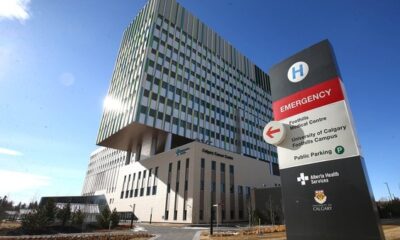World
Calgary Maintains Strong Credit Rating Amid Rising Debt Challenges

The City of Calgary has retained its long-term debt credit rating of AA (high), as affirmed by the credit rating agency Morningstar DBRS. This stable rating comes in light of increasing financial commitments tied to major infrastructure projects. Significant developments include the downtown revitalization, a new arena, upgrades to essential water infrastructure, and the Green Line LRT, which is set to become the largest transit project in Calgary’s history.
Councillor Andre Chabot acknowledged that the city faces rising debt levels, stating, “We do see the numbers go up significantly, and a lot of it has to do with how much we’ve taken on.” He expressed confidence in the city’s capacity to manage its debt, emphasizing that while it may constrain future flexibility, it should not adversely impact the credit rating.
According to Morningstar DBRS, Calgary’s adjusted taxpayer-supported debt is projected to be $523 per person in 2025, a figure considered low compared to other rated cities. By 2030, this amount is expected to rise to approximately $952, marking an 82 percent increase from 2025 levels. The agency’s report indicates that the anticipated debt increase is manageable under the current economic landscape.
Economic Trends and Infrastructure Investments
In an interview, Apurva Khandeparker, assistant vice-president at Morningstar DBRS, noted that while growth in Calgary’s economy has slowed this year due to trade uncertainties and changes in federal immigration policy, the energy sector remains stable. Production is increasing, and additional oil export capacity is being facilitated through the Trans Mountain pipeline. Furthermore, the expansion of Calgary’s tech sector is diversifying the local economy.
A recent report from the Conference Board of Canada forecasts a 1.8 percent economic growth rate for Calgary in 2025, ranking it second among large Canadian cities. Khandeparker highlighted that Calgary has consistently demonstrated strong fiscal management, maintaining a solid liquidity position and a historically low debt burden.
The financial landscape includes the $6.25 billion Green Line LRT project, which saw its budget increase by $705 million last year. Additionally, the city council authorized borrowing up to $1 billion for long-term water infrastructure projects during the previous budget discussions. Provincial regulations prevent municipalities from running deficit budgets, and Calgary’s history of posting strong operating surpluses positively influences its credit rating.
The city’s long-term outstanding debt (excluding Enmax-related debt) rose by $263 million to $2.96 billion between 2023 and the end of last year, with projections suggesting it could reach $4.5 billion by 2030. This year, borrowing will allocate $200 million for capital projects and another $200 million for city-owned Enmax Corp., according to the city’s treasury manager, Scott Brandt.
Future Challenges and Strategic Planning
Brandt emphasized the city’s ongoing growth and the associated capital requirements, stating, “The city is well positioned to manage the current and anticipated borrowing expectations.” Councillor Evan Spencer, chair of the audit committee, expressed that projects like the Green Line and the Scotia Place events center are vital reinvestments for Calgary, aimed at attracting further development, including new hotels near the BMO Centre.
Spencer cautioned that while major initiatives are staggered over several years to ensure financial manageability, the city must prioritize maintaining existing infrastructure. “Over the next stretch, this city cannot be adding massive projects without starting to put us in a more precarious position,” he remarked. He stressed the necessity of financial prudence to avoid jeopardizing future credit ratings.
Chabot reiterated that Calgary is currently well below its borrowing ceiling, having utilized only 40 percent of its total debt limit by the end of last year and 54 percent of its debt service limit. Despite this, he voiced concerns about the potential impact of continued borrowing on debt-servicing costs, particularly if new projects do not secure funding from higher levels of government or fail to generate anticipated revenue.
“Our financial limitations must be recognized,” Chabot stated. “The more we push that envelope, the more we’ll push our debt load up.” He believes that as long as the city refrains from excessive debt accumulation, Calgary will remain on stable financial ground.
The reaffirmation of Calgary’s credit rating by Morningstar DBRS highlights the city’s resilience and strategic financial planning, even as it navigates significant infrastructure investments and rising debt levels.
-

 Politics4 weeks ago
Politics4 weeks agoSecwepemc First Nation Seeks Aboriginal Title Over Kamloops Area
-

 World5 months ago
World5 months agoScientists Unearth Ancient Antarctic Ice to Unlock Climate Secrets
-

 Entertainment5 months ago
Entertainment5 months agoTrump and McCormick to Announce $70 Billion Energy Investments
-

 Science5 months ago
Science5 months agoFour Astronauts Return to Earth After International Space Station Mission
-

 Lifestyle5 months ago
Lifestyle5 months agoTransLink Launches Food Truck Program to Boost Revenue in Vancouver
-

 Technology3 months ago
Technology3 months agoApple Notes Enhances Functionality with Markdown Support in macOS 26
-

 Lifestyle3 months ago
Lifestyle3 months agoManitoba’s Burger Champion Shines Again Amid Dining Innovations
-

 Top Stories2 months ago
Top Stories2 months agoUrgent Update: Fatal Crash on Highway 99 Claims Life of Pitt Meadows Man
-

 Politics4 months ago
Politics4 months agoUkrainian Tennis Star Elina Svitolina Faces Death Threats Online
-

 Sports5 months ago
Sports5 months agoSearch Underway for Missing Hunter Amid Hokkaido Bear Emergency
-

 Politics5 months ago
Politics5 months agoCarney Engages First Nations Leaders at Development Law Summit
-

 Technology5 months ago
Technology5 months agoFrosthaven Launches Early Access on July 31, 2025


















